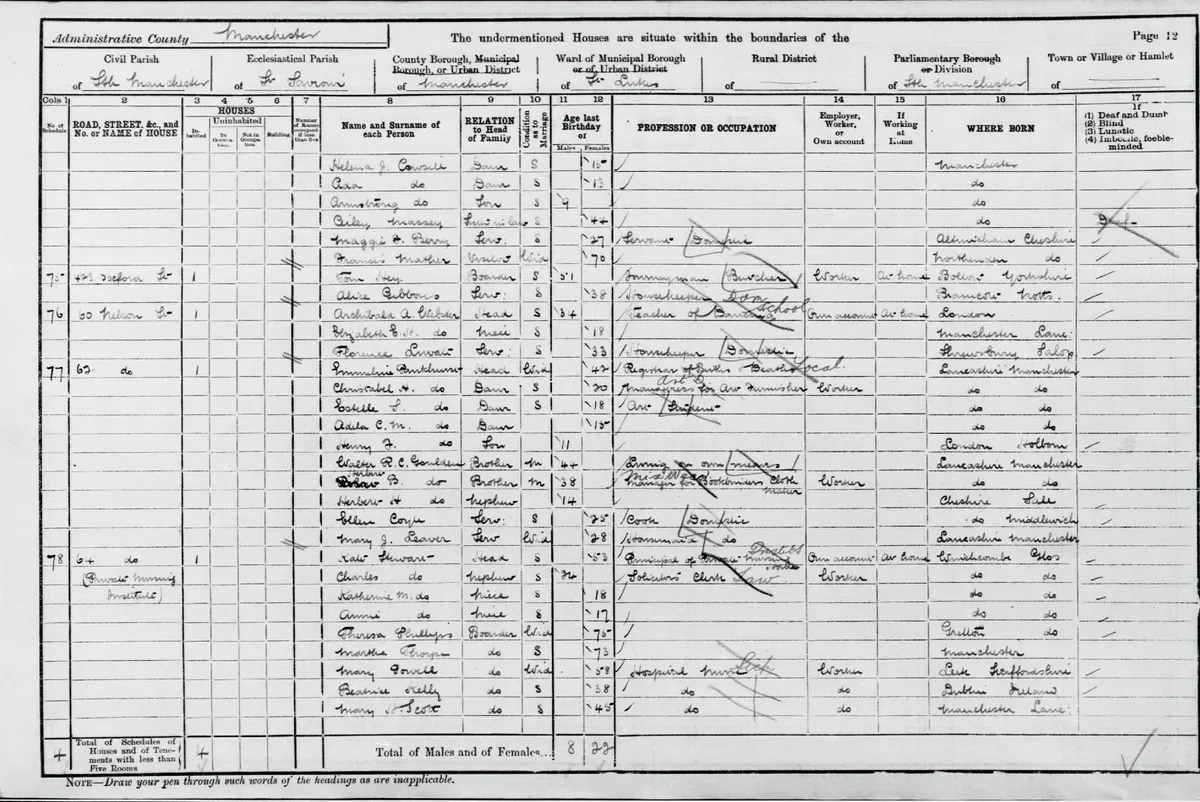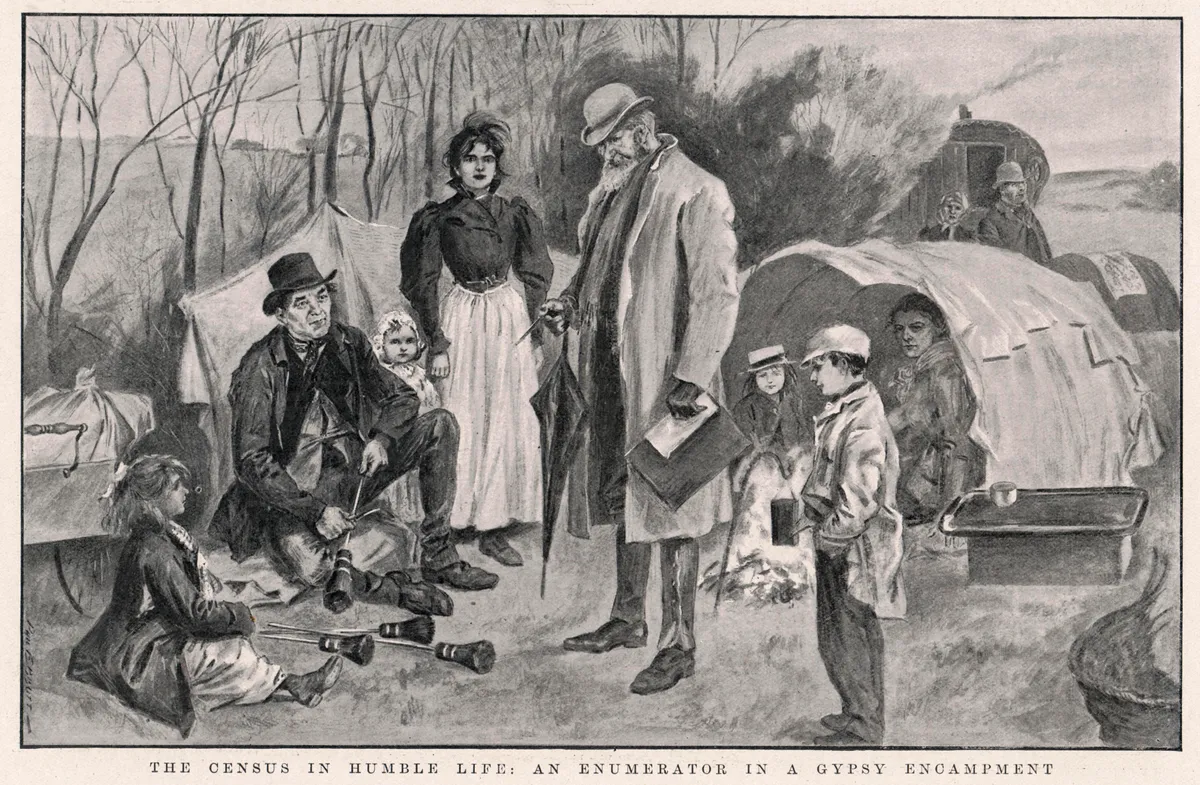Taken on the 31 March 1901, this census is sometimes called the centennial census, because it was 100 years since the first census in 1801. Although England, Wales and Scotland have almost complete census collections going back to 1841, the 1901 census returns are the earliest census records for Ireland that survive almost completely. They are available for free from the National Archives of Ireland. You can find out how to access the 1901 census for the whole of the UK below and in our guide to UK census records.
The 1901 census was held at a time when the nation was still in official mourning for the death of Queen Victoria on 22 January 1901; her elaborate state funeral had taken place on 2 February.
What was the population of the UK in 1901?
The 1901 census was the most detailed census to date, and found the total population of the UK was 41,458,721 of whom 21,356,313 were female and 20,102,408 male. The imbalance was because male deaths exceeded those of females, and more men went abroad to find work, administer the empire and serve in the forces. This 1,253,905 excess of women over men meant many more women were earning their own living and not relying solely on the work of male relations.
In England and Wales almost a third of women were in paid employment. This year women were employed for the first time as temporary clerks in the General Register Office (GRO), now on Millbank in Westminster, by the Thames. A ‘lady superintendent’ was engaged from the Post Office to supervise them, and many of these short-term workers became permanent GRO employees.
Women had long had a place in the telegraph service, taking down messages that came over the wires. Now they were engaged in operating the fast-developing technology of the new telephone exchanges. Men still outnumbered them in telegraphy and telephony, but women were catching up: there were 9,256 females here and 13,563 males.
There were three times the number of makers of 'cycles' and 'motors' compared with 1891
In a similar development, there were three times the number of makers of “cycles” and “motors” compared with 1891, showing an increase in cycling as a pastime and the development of the new industry of motor manufacture, which had centres in Coventry and Birmingham. However, the manufacture of horse-drawn vehicles still vastly outnumbered motorised ones.
What questions were asked in the 1901 census?

There was now only one column for householders to enter about their employment, headed “Employer, Worker or Own account”. Having a single column overcame the problem of people putting crosses in several columns as they had in previous censuses. This had irritated the officials, but was probably a reflection of genuine labour mobility: someone might be employed for part of their income but self-employed for another part; they might be employed to do a job that they then subcontracted so were both employee and employer. A new column was headed rather uncertainly “If Working at Home”. It appears to have produced no useful information nationally, because the census authorities did not include it in the tables compiled for the report.
Other changes this year firmed up the information that was available about households, birthplaces and infirmity. This census instruction clarified the definition of a “head of household”. It was the head of a family occupying the whole or part of a house. It is revealing of the Victorian attitude to the structure of society that “family” was defined as “a man and his wife and children (if any), also any relatives, visitors, servants, and persons boarding with the family, and residing together under one roof”. The term “lodger” was not used. A tenant who was living alone in a single room was effectively the head of a “family” of one.
The “Houses” column was split into four divisions: inhabited houses; uninhabited ones that were usually occupied; uninhabited houses that were not usually occupied; and those that were under construction (see the annotated document).
A concerted effort was also made to obtain more accurate birth data. Detailed instructions were asked of people in England and Wales about which county and town, or parish, they were born in. If they were born in Scotland or Ireland they were asked to name the county.
Those born in British territory abroad were asked for “the name of the Colony or Dependency”, while those who were born abroad had to state “British Subject”, “Naturalised British Subject” or “Foreign Subject” with specific nationality following.
Not only did a great many people not know in which county they were born, but a place which was now a town might easily have been a small village at the time of their birth
The chief clerk of the GRO was to complain “not only did a great many people not know in which county they were born but a place which was now a town might easily have been a small village at the time of the birth”.
The term “idiot” had been dropped. It had supposedly applied to people with congenital mental deficiency but its use as an insult had eroded its value in clinical definition, and most people had difficulty in distinguishing between an “idiot” with extremely limited capacities and an “imbecile” who could be educated or trained.
From 1901, “imbecile” was taken to cover all levels of congenital mental incapacity. However, the term “feeble minded” was now introduced. This was probably responsible for an increase in the recording of senile dementia among the elderly, now that a less derogatory term was used. These terms, however, were never adequately defined or widely understood. A lack of clarity was disparaged by the compilers of the Scottish household schedule who ordered: “Do not use such general terms as ‘Afflicted’ or ‘Infirm’.”

There was a loss of population through outward migration in all four UK countries. Emigrants from England and Wales had exceeded immigrants for 50 years. Scotland also saw a net loss through emigration. The loss was most marked in Ireland, where emigration and early death meant that there were now 4,458,755 people in Ireland, half the number there had been in 1841 before the famine. The population of England and Wales totalled 32,527,843, while Scotland’s was 4,472,103.
What questions were asked in the 1901 census for Ireland?
This year the Irish census asked educational questions that were not included in the rest of the UK. The form required to know whether a person could “Read and Write”, could “Read” or “Cannot Read”. The Irish census also asked religious profession, warning, “Members of Protestant Denominations are requested not to describe themselves by the vague term ‘Protestant’ but to enter the name of the Particular church, Denomination, or Body to which they belong.” There were found to be some three million Catholics in Ireland compared with one million Protestants. This year’s household returns are the earliest census records for Ireland that survive almost completely. They are held at the National Archives of Ireland in Dublin, and are available for free at census.nationalarchives.ie.
Where to find 1901 census records
How to access 1901 census records for England, Ireland, Scotland and Wales
Ancestry £
Index (including occupation) and images for England and Wales. Index-only for Scotland. Irish census index links to images on The National Archives of Ireland.
The National Archives of Ireland Free
Index and images for all of Ireland. Select 'More search options' to search by occupation, religion etc.
FamilySearch Free
Index shared with Findmypast for England and Wales. Occupations not indexed. Irish census index links to images on The National Archives of Ireland.
Findmypast £
Index and superior images for England and Wales with occupations indexed. Index-only for Scotland. Irish census index links to images on The National Archives of Ireland.
ScotlandsPeople £
Index and images for Scotland.
TheGenealogist £
Index (including occupation) and images for England and Wales. Index-only for Scotland.